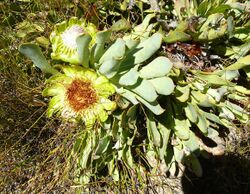Biology:Protea laevis
| Protea laevis | |
|---|---|

| |
| Scientific classification | |
| Kingdom: | Plantae |
| Clade: | Tracheophytes |
| Clade: | Angiosperms |
| Clade: | Eudicots |
| Order: | Proteales |
| Family: | Proteaceae |
| Genus: | Protea |
| Species: | P. laevis
|
| Binomial name | |
| Protea laevis R.Br.[2]
| |
| Synonyms[3] | |
| |
Protea laevis, also known as the smooth-leaf sugarbush,[4][5][6] is a flowering shrub that belongs within the genus Protea.[5][6]
In the Afrikaans language it is known by the vernacular names of gladdeblaardwergprotea[4] or gladde-blaarsuikerbos.
Taxonomy
Protea laevis was first described by Robert Brown in his 1810 treatise On the Proteaceae of Jussieu.[2][7][8]
Description
The plant takes the form of a prostrate shrub.[6] The main stem is subterranean.[8] It grows up to 80 centimetres (31 in) in diameter.[6] The above-ground branches are up to over 3 inches (7.6 cm) long, glabrous, prostrate, sometimes ascending.[8]
It has forms with narrow leaves, as well as forms possessing much broader leaves.[5]
It blooms in late Spring,[5] from September to February, with the peak from September to November. The plant is monoecious with both sexes in each flower. The seed is stored in a capsule within the woody, dried inflorescence, which is itself retained on the shrub after it is dead ('persistent'). The seeds are usually released one to two years after flowering and dispersed through by means of the wind.[6]
Distribution
This plant is endemic to the Western Cape province of South Africa .[4] It occurs from the Cederberg to the Hex River Mountains and Waboomsberg (which is one of the Koue Bokkeveld Mountains).[6] It occurs below the Langeberg in the Cederberg Mountains and on Hansiesberg in the Skurweberg Range of the Koue Bokkeveld Mountains.[5]
Ecology
Pollination occurs through the action of rats, mice and birds. The plant grows in dry, rocky, mountain ledges at altitudes of 1000 to 1800 metres. Potential wildfires destroy the adult plants, but the seeds are able to survive such events.[6]
Conservation
It is rare, and usually found as solitary individuals or in isolated, small groups of less than two dozen plants.[6] The population numbers are thought to be stable.[4]
References
- ↑ Rebelo, A.G.; Mtshali, H.; von Staden, L. (2020). "Protea laevis". IUCN Red List of Threatened Species 2020: e.T113210272A185560433. doi:10.2305/IUCN.UK.2020-3.RLTS.T113210272A185560433.en. https://www.iucnredlist.org/species/113210272/185560433. Retrieved 18 November 2021.
- ↑ 2.0 2.1 "Protea laevis". The Royal Botanic Gardens, Kew, Harvard University Herbaria & Libraries and Australian National Botanic Gardens. https://www.ipni.org/n/705889-1.
- ↑ "Protea laevis R.Br.". Kew Science. 2017. http://powo.science.kew.org/taxon/urn:lsid:ipni.org:names:705889-1.
- ↑ 4.0 4.1 4.2 4.3 Rebelo, A.G.; Mtshali, H.; von Staden, L. (29 May 2005). "Smooth-leaf Sugarbush". South African National Biodiversity Institute. http://redlist.sanbi.org/species.php?species=799-67.
- ↑ 5.0 5.1 5.2 5.3 5.4 "Protea laevis (Smooth-leaf sugarbush)". Iziko - Museums of South Africa. http://www.biodiversityexplorer.info/plants/proteaceae/protea_laevis.htm.
- ↑ 6.0 6.1 6.2 6.3 6.4 6.5 6.6 6.7 "Western Ground Sugarbushes - Proteas". 11 March 1998. https://www.proteaatlas.org.za/sugar1.htm.
- ↑ Brown, Robert (1810). "On the Proteaceae of Jussieu". Transactions of the Linnean Society of London 10 (1): 91. doi:10.1111/j.1096-3642.1810.tb00013.x. https://zenodo.org/record/1447522. Retrieved 19 July 2020.
- ↑ 8.0 8.1 8.2 Stapf, Otto; Phillips, Edwin Percy (January 1912). "CXVII. Proteaceæ". in Thiselton-Dyer, William Turner. Flora Capensis; being a systematic description of the plants of the Cape Colony, Caffraria & Port Natal. 5. 1. London: Lovell Reeve & Co.. pp. 604, 605. doi:10.5962/bhl.title.821. https://www.biodiversitylibrary.org/page/706077.
Wikidata ☰ Q18080116 entry
 |


